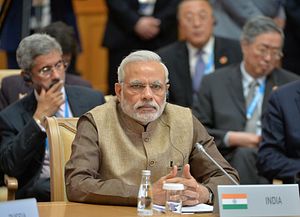Indian Prime Minister Narendra Modi’s visit to the United Arab Emirates (UAE) later this week has once again brought to focus India’s changing role in the Middle East. This will be the first visit by an Indian prime minister to the UAE in 34 years. Then-prime minister Indira Gandhi visited the Emirates in 1981. Former Prime Minister Manmohan Singh was to travel to the UAE in March 2013, but the visit was cancelled at the last minute.
India’s policy toward the Middle East has often been viewed through the prism of Indian–Iranian relations. The international community, and the West in particular, has been obsessed with New Delhi’s ties to Tehran, while missing India’s much more substantive simultaneous engagement with Arab Gulf states and Israel. India’s engagements with Arab states in the Middle East have gained momentum in the last few years, even as Iran continued to hog the limelight. India wants to secure energy supplies and consolidate economic and trade relations with the Gulf States, while those states (Bahrain, Kuwait, Oman, Qatar, Saudi Arabia, and the UAE, or the members of the Gulf Cooperation Council) have adopted a “Look East” policy that has allowed them to carve out a much more substantive relationship with India than in the past.
The economic dimension of India’s Gulf policy has become more pronounced in recent years as well. As a group, the GCC is India’s second-largest trading partner, the largest single origin of imports into India, and the second largest destination for exports from India. The UAE itself was the third largest trading partner of India in 2014-15, after the United States and China, with a bilateral trade volume of $60 billion. The GCC countries supply 45 percent of India’s petroleum, with the UAE being the sixth largest source of oil.
The GCC countries remain a major destination for Indian investment, even as India is making a concerted attempt to encourage GCC investment in India. India hopes that major GCC states such as Saudi Arabia, the UAE, and Oman would participate in India’s planned infrastructure expansion. With a rising demand for infrastructure development, India is looking for large investments from the Gulf, which is flush with funds due to the recent surge in oil prices. The Gulf States meanwhile are interested in human resources from India in order to develop sectors as varied as information technology, construction, transportation, and services.
Energy is clearly the driving force in Gulf–Indian relations. The GCC countries supply 45 percent of India’s petroleum; the Saudis are responsible for a quarter of those supplies, and Kuwait, Oman, and the UAE are other major suppliers. Qatar remains India’s exclusive supplier of natural gas, annually supplying five million tons of LNG to India. The Iranian government’s decision to renege on some oil supply commitments, after India’s vote against Iran at the IAEA, has also spurred New Delhi to diversify suppliers.
India’s trade and energy security is inextricably linked to the security of the Straits of Hormuz and Bab el-Mandeb. With this in mind, the Indian Navy regularly visits Gulf ports and trains with states in the region. The Indian Navy has undertaken a series of naval exercises with a number of Gulf States in recent years, thereby lending its hand to Indian diplomacy in expanding India’s reach in the region. Indian warships have also been deployed in the Gulf of Aden to carry out anti-piracy patrols on the route usually followed by Indian commercial vessels between Salalah (Oman) and Aden (Yemen). The Gulf of Aden is a strategic choke point in the Indian Ocean and provides access to the Suez Canal, through which a sizable portion of India’s trade flows.
In addition, Indians are the largest expatriate community in the GCC states, numbering around 7 million. There are an estimated 2.6 million Indians in the UAE alone. Indian expatriate labor constitutes around 30 percent of the total population of the UAE, and Indians have a significant presence in Bahrain, Oman, and Qatar. India receives remittances worth around $6 billion annually from its Gulf expatriates. These remittances have contributed significantly to India’s economic resurgence, even as there have been growing concerns in recent years about the living and working conditions in the host countries. India is pursuing manpower and labor agreements with Gulf States to help Indian workers in the region. Modi’s outreach to the expatriates in the UAE is going to be the highlight of his visit.
For all these reasons, Modi’s visit to the UAE is going to be significant and it will once again underline India’s continuing stakes in a region that is growing through a period of momentous change. Much like the regional states, India would also like a stable balance of power to emerge in a region riven with multiple fault-lines.
































